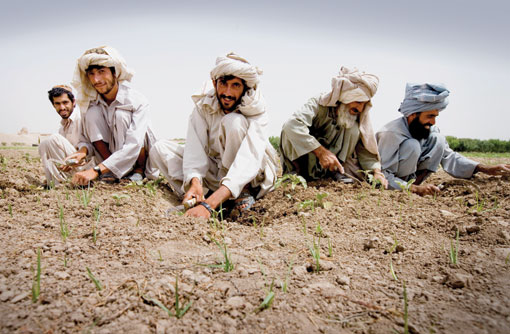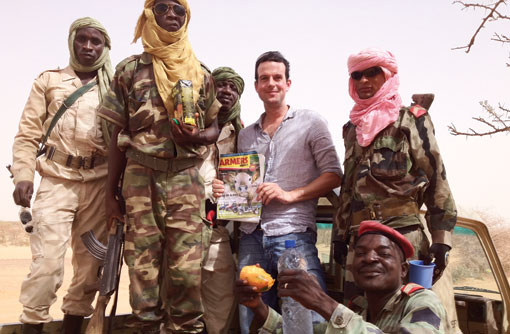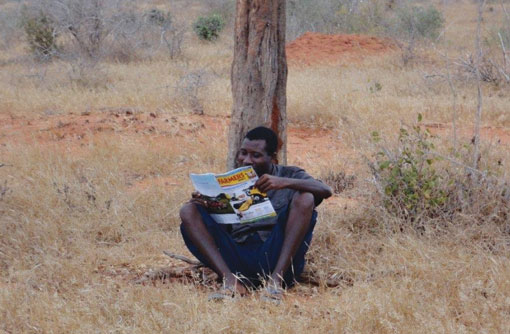Afghan farmers a force for good

The headlines may tell of tragedies, bombs and bullets – but there is another story beginning to emerge from the conflict in Afghanistan. It’s how agriculture is being used as a force for good.
Travelling through the food-growing zones of Nad Ali and Nar-e-Saraj, there is every shade of green from the pastel wheat and barley through to the richness of cucumbers and leafy vegetables. This is also the country’s fruit basket, with pomegranate, grape, apricot, melon and tomatoes in abundance, bringing colour and prosperity to the bazaars.
Pashtun farmers can grow three crops in a year-round crop cycle – a staple of wheat or corn as the main crop, with melons or tomatoes, followed by vegetables such as onions or carrots.
The Helmand river valley, with its network of irrigation channels, is the most fertile in Afghanistan. For the people of this province, land and water – along with security – is everything. But more than 30 years of war has left the country’s infrastructure devastated, first by the Soviets, then the Taliban.
The past 10 years have seen security and reconstruction teams fighting to drive the Taliban out and bring stability and economic development. Reducing poppy growing has been a key goal and the British Army’s Military Stabilisation Support Team (MSST), are at the forefront of developing alternative livelihoods.
The MSST are a unique tri-service operation comprising soldiers, sailors and airman, trained in a variety of skills to support the regeneration. They also make use of reservists who have specialist knowledge from their day jobs. These include engineers and project managers and, in the case of Major Richard White of the Royal Wessex Yeomanry, who’s a partner with Strutt & Parker, agricultural land management experience.
“One of the key challenges is moving around,” says Richard, who was deployed this year. “The challenge for both the MSST and the Afghan farmers is repairing or replacing the infrastructure smashed by the Taliban and the Soviets in the 1980s.”
Starved of education and access to modern technology, Afghan farmers have struggled to take advantage of this fertile land, but that is now changing.
The Battle Groups have pushed the Taliban out and are now clearing the fields of IEDs to allow the farmers to grow new crops safely. There is a cautious optimism as farmers move back into the rural areas to reoccupy the farms they were forced out of.
Training
There are a range of programmes, from basic tractor maintenance, water management and new crop types through to seed and sapling distribution schemes. Just outside Lashkar Gar a research and demonstration farm has been established by Afghanistan’s Ministry of Agriculture, Irrigation and Livestock. One of many results from the training is that wheat yields have improved from 4.1t/ha to 4.7t/ha.
Livestock also plays its part in this rural economy. There is a burgeoning dairy trade in Helmand although herds are small, sometimes no more than two or three animals per farm. Richard helped set up a forum for the local dairy farmers to resolve issues such as milk being diluted and problems transporting milk to market.
Although set up by the MSST, the Afghan farmers are encouraged to take the lead and find the appropriate Afghan solution, rather than be led by the military.
Other areas where the British team is helping is in the provision of veterinarian services and army vet Captain Harriet Church has been advising on husbandry, animal welfare and vaccines. Afghanistan is typical of the region in that the tribes are many and various. The Kuchi are a nomadic tribe who survive by moving herds from one part of the country to another, as seasons change. The Kuchi have received help to enhance their red meat value chain.
The international effort includes an Agricultural Development Team, a contingent of the US National Guard from South Carolina. The civilian-soldier team members are selected for their different agricultural expertise. Their role is to provide training and advice to Afghan universities, provincial ministries and local farmers to increase stability and improve Afghanistan’s shattered agribusiness sector. The team consists of what some refer to as “combat farmers” – soldiers at heart with an agricultural background. Many of the team members have farms in South Carolina.
There is a long way to go before Helmand will be a thriving agricultural region. The security and safety of farmers will need to be maintained by the Afghan National Security Forces. The government of Afghanistan will have to continue the education and training of people. They will also have to maintain and develop the infrastructure and create new markets to encourage farmers to continue to move away from poppy growing.
The landscape in Helmand is still biblical and the farmers are still poor and under-resourced. It may be many years before the wheat grown in Helmand is milled there or the fruit and veg grown in Nahr-e-Saraj or Nad Ali reaches the markets of Kabul, but Afghanistan has an opportunity to embrace Helmand Province and its farmers to make a significant contribution to its future.
The farmers can deliver the produce, support the economy and provide the voice of stability for its children. The green zone could be the key to sustainable future. In this ochre-coloured landscape of extreme heat and desert, there are positive signs for the future. Those signs are in the fields of Afghan farmers.
Rebuilding and replanting
- International funding has established three District agricultural training centres in Geresk, Marjah and Nawa.
- In the past year, more than 17,000 farmers (including 300 women) have been trained in agricultural skills.
- The USAID Commercial Horticultural Agricultural Marketing Programme has distributed 250,000 saplings and enabled 1,500 trained farmers to establish 323ha of fruit orchard, set to increase by 190ha with a 40ha vineyard.
- The Alternative Livelihoods wheat seed programme has contributed to the province’s 39% reduction in poppy cultivation over the past four years.
- A total of 118.5km asphalt roads built to take produce to market; another 150km-plus planned for 2012/13.
Ag mag on tour
Farming is a truly global industry – from warzones like Afghanistan to the most peaceful of villages. Here are some of the pictures we’ve been sent by readers who have snapped themselves reading their favourite ag mag in places that are a little more unusual than the sitting room or the kitchen table.
 Sam Farmar sent in this picture from a trip to Niger to report on the looming famine. “This is my security team,” he says. “I was taken up to near the Mali border where food is very scarce.”
Sam Farmar sent in this picture from a trip to Niger to report on the looming famine. “This is my security team,” he says. “I was taken up to near the Mali border where food is very scarce.”
 James & Clare Murrell from Willow Farm in Norfolk took this picture of a self educated Kenyan farmer named Syria reading the Farmers Weekly under a tree in the Tsavo East National Park. “We gave him the magazine to look at after we had read it and he couldn’t put it down. He was fascinated to see the different machines we use,” said James. “He was shocked that we don’t employ anyone to help on the farm. He told me in Kenya they use cheap labour not machines to do the harvest. Syria farms cashew nuts and coconuts and everything is done by hand.
James & Clare Murrell from Willow Farm in Norfolk took this picture of a self educated Kenyan farmer named Syria reading the Farmers Weekly under a tree in the Tsavo East National Park. “We gave him the magazine to look at after we had read it and he couldn’t put it down. He was fascinated to see the different machines we use,” said James. “He was shocked that we don’t employ anyone to help on the farm. He told me in Kenya they use cheap labour not machines to do the harvest. Syria farms cashew nuts and coconuts and everything is done by hand.
 Phil Gorringe at the top of Laguzoi mountain in the Italian Dolomites. “It’s an interesting place as it was scene of protracted conflict during the First World War between Italians and Austrians. They occupied ledges on the mountain some 2,000m up for two or three years and the fighting involved either dropping explosives on each other or trying to tunnel secretly behind/underneath the opposition to plant explosives and blow them up. It’s very exposed and was a feat of endurance without the added joys of being shot at! And the views are stunning.”
Phil Gorringe at the top of Laguzoi mountain in the Italian Dolomites. “It’s an interesting place as it was scene of protracted conflict during the First World War between Italians and Austrians. They occupied ledges on the mountain some 2,000m up for two or three years and the fighting involved either dropping explosives on each other or trying to tunnel secretly behind/underneath the opposition to plant explosives and blow them up. It’s very exposed and was a feat of endurance without the added joys of being shot at! And the views are stunning.”
Send us your pictures
If you’re going away, pack a copy of Farmers Weekly and send us a photo – you can upload it direct to our gallery or email fwfarmlife@rbi.co.uk
